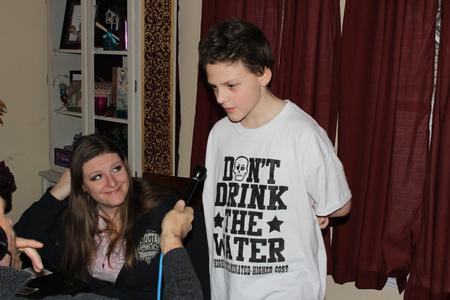Flint Residents Still Paying for Switch to Contaminated River Water
Water has become the enemy for some in Flint, after tests revealed it was contaminated with lead.

Flint Mayor Karen Weaver met with Governor Rick Snyder today to discuss the water crisis in the city.
Snyder declared a state of emergency in Flint this week, citing ongoing concerns about lead contamination in the city’s drinking water.
The city began using the corrosive Flint River for its water in 2014 as a way to save money, until it was forced to switch back to Detroit’s supply a few months ago.

But Flint residents are still paying for the water switch with their wallets and their health.
That includes 37-year-old Melissa Mays, who routinely shrinks back now from the steel sink in the kitchen of her modest, two-story home in Flint.
For Mays, the water that researchers say has leeched lead and copper from Flint’s pipes has become the enemy.
“Hot water condenses the metals and contaminants and releases them into steam,” Mays said. “So then you breathe it in and you inhale it, it absorbs through your pores, like your feet. So that’s why I don’t allow hot showers. I had to send my husband to go get a case of water today otherwise I’m not going to be able to make dinner.”
Mays says her family spends roughly $100 a week on bottled water now. They drink it, cook with it and pour cups of it over their heads to bathe.
“I use, like, clean wipes. I don’t use water to clean anymore, even for the floors. You have to flush the toilet with it and a lot of times even now it smells so much like bleach it makes your eyes water. I did a load of laundry and it stunk my whole house up to where I had to open all the windows. It smelled like open sewage. I’m like ‘Oh here’s today’s smell.’ ”
The water began smelling bad and looking funny in April, 2014, right after the city changed to the Flint River as its source of drinking water.
By last summer Mays says many people in Flint were becoming very sick.
She said, “I got this big giant rash on my cheekbone. It was like a chemical burn. And turns out it WAS a chemical burn. And it hurt so bad. And everybody was like, ‘Oh I’ve got one of those too, like between my fingers. I can’t do my dishes without gloves.’ And you just kind of blow it off ‘cause (the state and the city) told us it’s safe, it’s fine.”
Medical bills began to mount for Mays and her children.
She’s still employed, and her husband, Adam, is working two jobs seven days a week.
But Adam Mays says he fears going to the doctor himself because he knows what the results likely would be.
“I feel it. You know, I just can’t remember things anymore. Always a constant fog. It’s hard. It’s a different lifestyle now,” he said.
Melissa Mays nods in agreement.
“And the thing is that we’ve all adapted to this regular way of life. Oops, don’t touch the water.”
Mays says that extends to her three children as well, noting that anytime the family goes to a restaurant, or even a residential home, the first question asked is whether the food or drink has any Flint water in it.
That’s been a significant change for 11-year-old Cole Mays, who had a hard year in 2015.
He says he’s often ill now, just like his two older brothers, and has to avoid the hot baths and fast food prepared in Flint that he used to love.
“Well, anything to keep me alive,” he said.
Lead exposure can cause permanent brain damage and children are especially at risk.
Melissa Mays says after Flint switched its water supply her sons went from being straight-A students to struggling with basic studies.
“And I worry because they’re gonna need tutors,” Mays said. “Because I don’t want them to just be set aside and (told) ‘Well okay, your IQ’s a little lower.’ No. I want them to be where they were before this happened.”
Yet Mays says there’s little money available for tutors.
Daily life in Flint has drained her family’s savings.
“Our garbage disposal just corroded, so that’s another hundred bucks. Went through three water heaters and they’re $500 a pop. And that was…that was it. ‘Cause the rest of it’s gone towards medication. Me being off work and he’s had to miss work from time to time to take care of me and the kids. So yeah, we’re paycheck to paycheck at this point.”
Ironically Mays says her water bills have skyrocketed.
Refuse to pay them and the city will shut off the taps. On top of that, Child Protective Services could remove any children living in a house with no running water.
And Mays says moving away from her house in Flint is not an option.
“We’re not gonna be able to sell it, for one, because it’s not legal to sell your home with known copper and lead problems until you replace those problems. So there’s that thousands of dollars to do the service line and indoor plumbing. And nobody wants to buy a poison water house.”
Instead Mays joined two lawsuits filed against the city and the state, one backed by groups like the American Civil Liberties Union, the other by attorneys working pro bono.
The U.S. Justice Department is also investigating if the state knowingly allowed Flint residents to use contaminated water.
For Mays, there’s more than enough guilt to go around.
“I blame the city of Flint, I blame the Governor, everybody who had any hand in this, you know, to save money. But at the end of the day, when I go to sleep, I cannot forget that I’m the one that handed the water to the kids.”
And the true price for Flint’s attempt to save money by using river water remains unclear.
Experts say the full effects of lead poisoning cannot be seen until five years after exposure.
